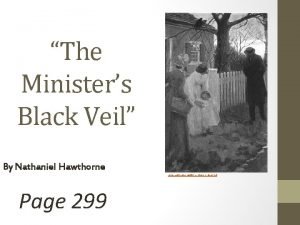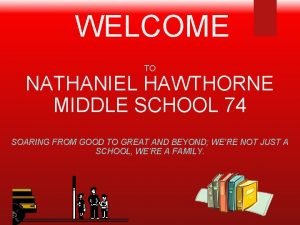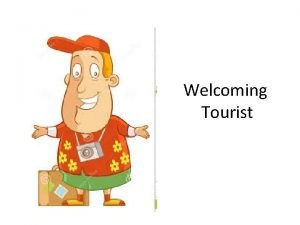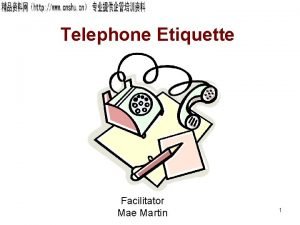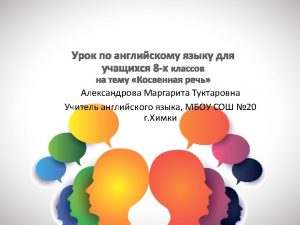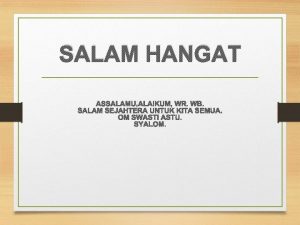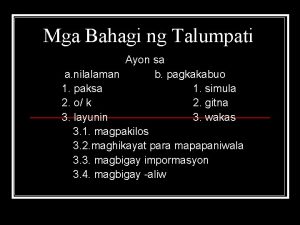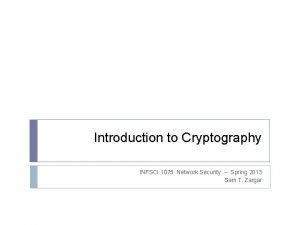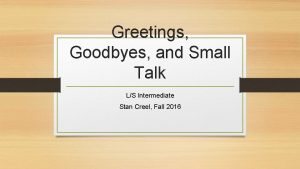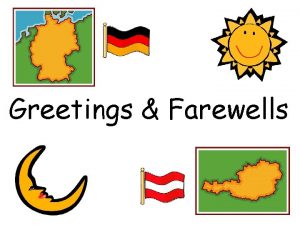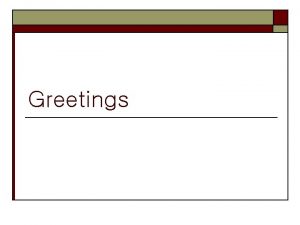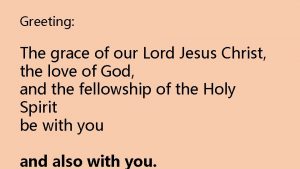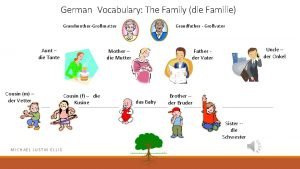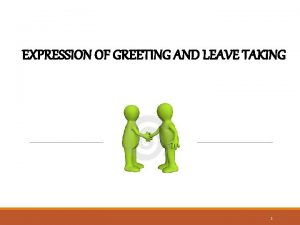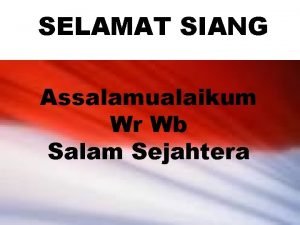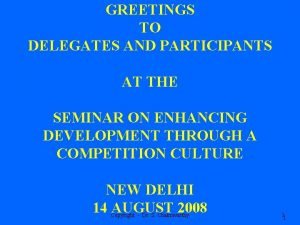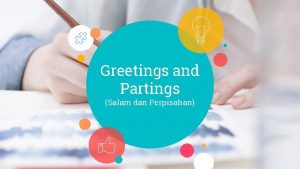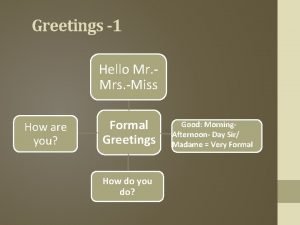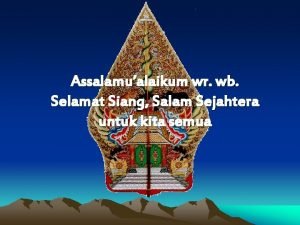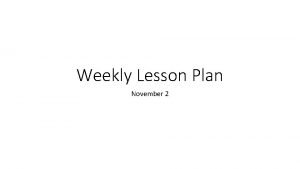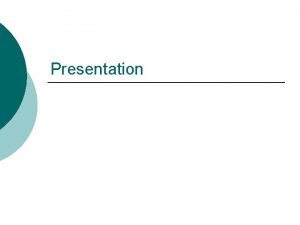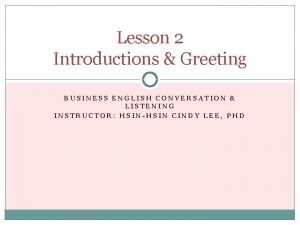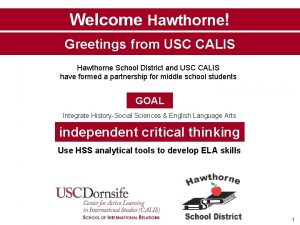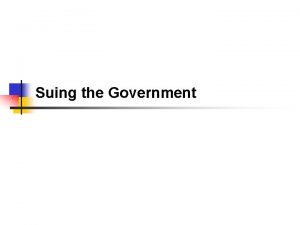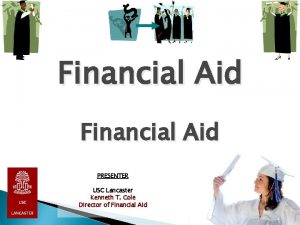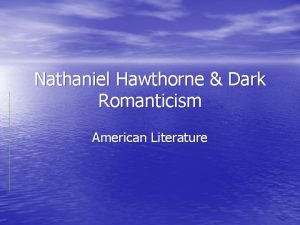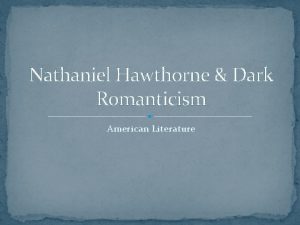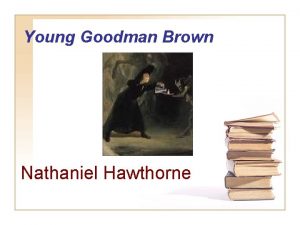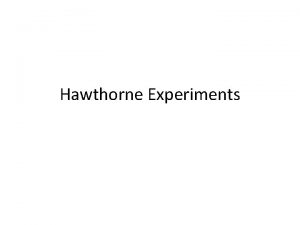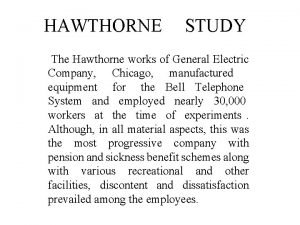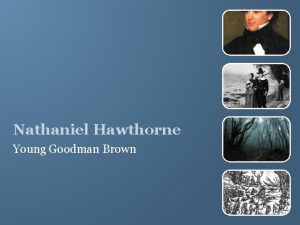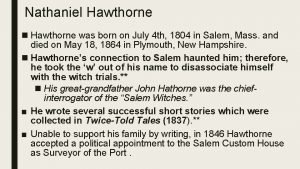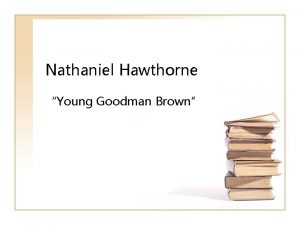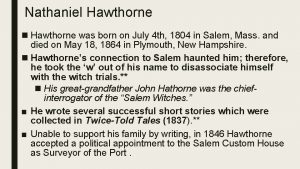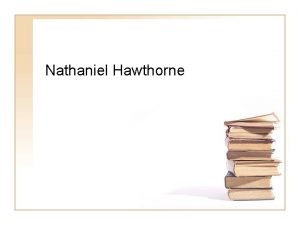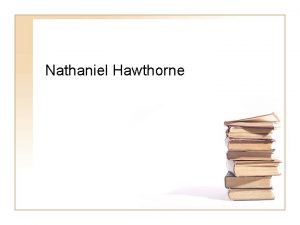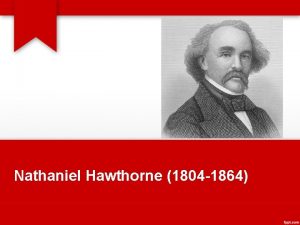Welcome Hawthorne Greetings from USC CALIS Hawthorne School


















![Julius Caesar: An enemy of the state? Caesar: [to the troop leader] Any of Julius Caesar: An enemy of the state? Caesar: [to the troop leader] Any of](https://slidetodoc.com/presentation_image_h2/059b409b5ed77b36b8e1076d78f12b96/image-19.jpg)


















- Slides: 37

Welcome Hawthorne! Greetings from USC CALIS Hawthorne School District and USC CALIS have formed a partnership for middle school students GOAL Integrate History-Social Sciences & English Language Arts independent critical thinking Use HSS analytical tools to develop ELA skills 1

Independent Critical Thinking Input listening reading INPUT Output speaking writing active reading & active listening = be able to infer & relate concepts/ideas (factors, virtues, etc. ) = be able to think critically about information/ideas OUTPUT clear, cohesive speaking & writing = be able to further synthesize, evaluate information/ideas = be able to express critical thinking 2

Independent Critical Thinking Once you are equipped to be a critically thinking listener and reader, then you are equipped to be an articulate speaker and writer. As your understanding of history deepens, your skills in language arts will grow. The art of teaching is the art of assisting discovery. Mark Van Doren USC CALIS │ School of International Relations (IR) 3

Social Sciences & Language Arts Integration 7 th Grade Medieval & Early Modern World History Rome: The Fall of the Rome Inquiry Arc � Focus Question What was the most important factor that caused the fall of the Roman Empire? � Culminating Writing Prompt What was the most important factor that caused the fall of the Roman Empire? Describe the context of factors that were challenging the empire to explain why a certain factor was the primary cause. Was the empire destined to fall? 4

story Four Worlds of History Geography & Technology affect all Four Worlds Political World Economic World Social Science Factors tell the story of history Social World Cultural World As you build your skills to identify & relate factors, you can learn from age-old challenges that we face today 5

Four Worlds of… Water How is water part of each world? Political World How is government involved with water? Social World How is water a class issue? Economic World What kinds of products & services involve water? water Cultural World Does water have special meaning for some people or special uses? 6

Which factors can be related to this image? Political World Economic World managing the commons public goods production natural resources infrastructure innovation & efficiency water Social World lack of equity Cultural World religion identity & access practices rites & rituals 7

What is your best 4 W analysis of Sponge. Bob? Political World Social World Economic World Cultural World 8

s! world r u o f n i e I liv Political World Social World Each world has different influences on me and I have a role & influence in each world, too! Economic World Cultural World 9

4 W Inventory – Factor Review Using three different colors, highlight the factors on the factor sheet that were identified in each 4 W exercise water Sponge. Bob me Over time, you can build your familiarity with social science factors and continually deepen your understanding 10

Throughout all time and all places, people want leaders to… _____? Good leaders “protect & serve” their people. Political World Economic World leadership public servant challenges to governing: corrupt officials power struggles (between officials or military generals) Social World Cultural World trust respect expectations Compare the role of leadership in the rise and fall of the Roman Republic and Roman Empire. 11

Forms of Government vs. Effective Leadership Around 500 BCE, the people of Athens decided to try governing themselves. They developed democracy, or “rule by the people”… Not all Greeks believed that democracy was a good type of government. Powerful speakers sometimes persuaded ordinary citizens to vote unwisely. Often, the assembly reversed important decisions after just a few weeks. Because of problems like these, most city-states returned to earlier forms of government, such as dictatorships and oligarchies. Did something similar happen with Romans? Source: History Alive! The Ancient World, TCI, 2004 — page 257 12

millennium scale Timeline: Roman History – the big picture How many years is this Roman History from the Republic to the Fall of Constantinople? Birth of the Republic 509 + 1453 1962 years almost 2000 years 1000 509 Origins of Rome BCE Etruscan Kingdom Second Millennium Birth of the Empire First Millennium BCE Fall of Rome Byzantine Empire 476 Roman Empire in the East continues 1 BCE 1000 500 Fall of Constantinople 1000 Fall of the Republic Roman Republic lasts for over 400 years 500 First Millennium …and lasts for another 1000 years Civil Wars Plebs 200 -yr struggle for equality BCE Roman Empire in the West lasts for over 400 years 1 Overseas Expansion Conflict of Orders: 494 287 BCE 8 th century BCE Unification of Italy 2017 1776 241 years 1776 How old is the USA? United States of America 1453 1500 19 th century 2000 You Are Here 2000 Third Millennium 2500 3000 13

The Roman Republic was continually evolving to be a more true democracy of shared power The plebs struggled for over 200 years to gain political equality with the patricians. Little by little, they won more rights: � Limited Voice/Representation (Tribunes) � Partial Legislative Power (Council of Plebs) � Written “Constitution” (Twelve Tables) � Rule of Law (laws applied to all) � Veto Power � Equal Representation � Full Legislative Power Why would they ever go back to a dictatorship? Forms of Government vs. Effective Leadership 14

Timeline: From Republic to Empire – a closer look He always supported the rights of the common people. He was the plebeian’s favorite politician. Civil Wars Julius Caesar claims sole rule & restores order Generals used their armies to gain fame in far-off lands and then fight for power in Rome In one civil war in the 80 s BCE, 200, 000 Romans were killed century scale Birth of the Empire 45 BCE 27 BCE 40 years later, another civil war broke out between two generals, Pompey and Julius Caesar Assassination of Julius Caesar 44 BCE “bloody power struggle” Fall of the Republic Roman Republic 100 1 st century 2 nd century 1 st century BCE Death of Augustus at age 75 14 Augustus Caesar First Emperor 50 the 80 s BCE “Octavian emerged as the winner” 1 BCE During his rule, a long period of peace and prosperity began. Pax Romana: 27 BCE – 180 CE Roman Empire 100 50 180 200 15

Roman Dictators / Dark Knights An unusual feature of the Roman Republic was the office of dictator. Today, we define a dictator as an oppressive ruler with complete control over the state. Roman dictators also had complete control, but they only ruled on a temporary basis during emergencies. The Senate appointed a dictator during times of great danger. As soon as the danger was past, Roman dictators gave up their power. Lucius Quinctius Cincinnatus During the first 50 years of the Republic The best-known early Roman dictator is Cincinnatus. About 460 BC, a powerful enemy had surrounded a Roman army… Cincinnatus left his farm and gathered an army. He defeated the enemy in short order and returned to Rome in triumph. Although he probably could have continued ruling, Cincinnatus did not want power. Having done his duty, he returned to his farm and gave up his dictatorship. During the plebs 200 -yr struggle for equality Conflict of Orders: 494 287 BCE Source: Discovering Our Past: Ancient Civilizations, Glencoe, 2006 — page 429 16

Cincinnatus’ Son: Caeso would assault not just any plebs, but the Tribunes of the Plebs! Caeso was tall and strong, and had earned a reputation as a fine soldier, to whom several feats of courage and daring were attributed. He was also considered an excellent public speaker. But in the disputes between the patricians and the plebeians, Caeso unreservedly took the side of the aristocratic party. His trial for obstructing the tribunes of the plebs in 461 BC was one of the key events in the Conflict of the Orders. Despite holding no position of authority, he and his followers took it upon themselves to prevent the tribunes of the people from meeting in the forum to conduct their business. If anyone dared oppose them, Caeso and his friends resorted to violence, driving away the plebeians and their representatives. Where did he get his views toward the plebs? The apple doesn’t fall far from the tree …with some exceptions? Source: https: //en. wikipedia. org/wiki/Caeso_Quinctius 17

Cincinnatus —Part 2 Cincinnatus, Roman patriot in the 5 th century BC, was consul in 460 BC and dictator twice (458 and 439). According to tradition, in his first dictatorship he came from his farm to defeat the Aequi and Volscians, who were threatening the city from the east and southeast. He returned from battle, resigned his dictatorship, and went home to his farm. In 439 he came out of retirement to put down the plebeians. The separation of legend from history in Cincinnatus' story is impossible. Cincinnatus was a protector of the Republic… but was he an enemy of the plebs? Who was a friend of the plebs? Source: http: //www. encyclopedia. com/topic/Cincinnatus. aspx 18
![Julius Caesar An enemy of the state Caesar to the troop leader Any of Julius Caesar: An enemy of the state? Caesar: [to the troop leader] Any of](https://slidetodoc.com/presentation_image_h2/059b409b5ed77b36b8e1076d78f12b96/image-19.jpg)
Julius Caesar: An enemy of the state? Caesar: [to the troop leader] Any of your people I can mention? Soldier: Titus Pullo took the head off the first man that came at him. Caesar: Sergeants, Pompey and the Senate have formally declared that Gaius Julius Caesar is an enemy of Rome. They have declared that I am a criminal. They have declared, in effect, that all of you also are criminals. --- Veto was not exercised. People's Tribune Mark Antony and 50 men of the 13 th were assaulted by a thousand head of Pompeian scum. A Tribune of the Plebs assaulted on the steps of the Senate House! Can you imagine a more terrible sacrilege!? ! Our beloved Republic is in the hands of madmen! This is a dark day and I stand at a fork in the road. I could abide the law and surrender my arms to the Senate and watch the Republic fall to tyranny and chaos, or I can go home with my sword in my hand run those maniacs to the Tarpeian Rocks! Legionary Titus Pullo step forward. Titus Pullo and 50 brave men of the 13 th fought Pompey's thousand in the forum and saved the Tribune. It was legionary Titus Pullo drew first blood. …Here is 500 denari. Pullo: Very grateful, Sir. Caesar: Are you with me, Titus Pullo? Will you come with me to Rome? Pullo: Yes, Sir. Certainly! Caesar: Titus Pullo is with me. And you? Are you with me? Enemy of the State: Caesar's Speech to 13 th Legion http: //www. youtube. com/watch? v=5 Pe. N 1 k 9 AAMg — 2 min, 42 sec Source: The HBO mini-series Rome 19

A knight is a powerful protector. White Knight works within the system How do we distinguish Dark Knights from White Knights? Dark Knight works outside the system 20

Batman Why is Batman called the Dark Knight? 21

The Dark Knight: the hero we need? Natascha: No, come on—how could you want to raise children in a city like this? …I’m talking about the kind of city that idolizes a masked vigilante… Harvey Dent: Gotham’s proud of an ordinary man standing up for what’s right. Natascha: Gotham needs heroes like you—elected officials, not a man who thinks he’s above the law. Bruce Wayne: Exactly. Who appointed the Batman? Harvey Dent: We did. All of us who stood by and let scum take control of our city. Natascha: But this is a democracy, Harvey Dent: When their enemies were at the gate, the Romans would suspend democracy and appoint one man to protect the city. It wasn’t considered an honor. It was considered public service. Rachel: And the last man they asked to protect the republic was named Caesar. He never gave up that power. Harvey Dent: Well, I guess you either die a hero or you live long enough to see yourself become the villain. Look, whoever the Batman is, he doesn’t want to spend the rest of his life doing this. How could he? Batman’s looking for someone to take up his mantle. 22

The Dark Knight: the hero we need? After reading the script and then viewing the scene: 1. Why would the city “idolize” the Batman? 2. What does Natascha mean by “heroes like you” when referring to Harvey Dent? 3. What does Dent mean by “all of us who stood by” appointed the Batman? 4. What did it mean to “suspend democracy” to let one man protect the city? Watch the restaurant scene: You Either Die a Hero, or You Live Long Enough To See Yourself Become the Villain — http: //www. youtube. com/watch? v=z. Dz 8 CW 6 ut. WY — [2 min 1 sec] 23

How is there is a “fine line” between Dark Knights and villains? A Dark Knight has honorable qualities. Batman does not “enforce the law”. He stops crime. He catches criminals using high-tech gadgets, no guns. Then he turns them over to the police. But if he lets himself go too far and is cruel or destructive in his pursuits or does not act for the good of the people… then he becomes a villain. For some, a Dark Knight is a hero. Others see a villain. 24

Roman Dictators / Dark Knights Julius Caesar was born into a noble family, but he always supported rights of the common people. He was the plebeian’s favorite politician. They believed that he understood and cared about their needs. He did, but he was no saint. He was practical, strong willed, and hungry for power. Street-smart, he made very few mistakes, and he knew how to take advantage of the mistakes of his enemies. (1) As the Roman Republic grew larger and more populated, the task of maintaining order and stability became increasingly difficult. In addition, tensions arose between the different classes in Roman society. Eventually, Rome fell into a civil war, which is a conflict between different groups within a country. In 45 BCE, a powerful Roman general named Julius Caesar brought order to Rome and named himself sole ruler. This brought an end to the Roman Republic. (2) As dictator, Julius Caesar introduced many reforms. He gave work to thousands of Romans by starting projects to make new roads and public buildings. To keep the poor happy, he staged gladiator contests they could watch for free. He also adopted a new calendar that is still used today. (3) How was Julius Caesar a great example of a Dark Knight? 25

Roman Dictators / Dark Knights Octavius, Octavian Augustus Octavius donned the toga, the Roman sign of manhood, at age 16, and began taking on responsibilities through his family connections. In 47 B. C. he went to Hispania (modern-day Spain) to fight alongside Julius Caesar. He was shipwrecked along the way, and had to cross enemy territory to reach his greatuncle—an act that impressed Caesar enough to name Octavius his heir and successor in his will. Augustus Caesar 63 BC -– 14 AD From the HBO mini-series Rome As the first Roman emperor (though he never claimed the title for himself), Augustus led Rome’s transformation from republic to empire during the tumultuous years following the assassination of his great-uncle and adoptive father Julius Caesar. He shrewdly combined military might, institution-building and lawmaking to become Rome’s sole ruler, laying the foundations of the 200 -year Pax Romana (Roman Peace) and an empire that lasted, in various forms, for nearly 1, 500 years. How was Augustus Caesar both a dictator and Dark Knight? 26

Inspired by 90 seconds to prepare in pairs, then… Pass the mic Indeed, Romans repeated history and did what the Greeks did by returning to earlier forms of government, including dictatorships. How does the concept of a Dark Knight explain this seemingly poor choice? 27

Good leaders “protect & serve” their people. Political World Economic World leadership Roman Dictators In the final years of the Roman Empire, was leadership a pivotal factor? Social World Cultural World respect Describe the context of factors that were challenging the empire. Explain why a certain factor was the primary cause. Was the empire destined to fall? 28

1 What is the Four Worlds model and how does it work? Political World (transcript of student discussion) Economic World It’s a system of organizing everything that takes place into one of 4 major categories… We’re focusing on sorting. Factors can influence these four sections in any way and can be combined with any of them. Jordan, 8 th grade The factors all can connect depending on one specific example and you can see originally how you place it into one category, and see how it connects to the other three worlds that you at first, didn’t think it would belong in. Audrey, 8 th grade I think it’s cool how each of the Four Worlds can affect each other in many different ways like a domino effect. If one thing happens in one world, it can affect lots of other things in different worlds. Noah, 7 th grade Social World Cultural World 29

2 How is Four Worlds different from other ways of learning history? Political World (transcript of student discussion) Economic World Before [at my other school] I was just learning important dates and main ideas – basically trying to memorize it. But since using the Four Worlds, I’ve been able to see why these are important dates. Also how they affected life back then and how it affected life today. How there’s not always just a simple ‘this is the answer and it’s the only answer’. There are multiple answers, and thinking outside the box, and thinking more thoroughly than I was before. . Spencer, 8 th grade The Four Worlds also helped me because it’s not just regurgitation, it’s analysis. So you can really understand the facts and condense them in a way you can understand. Madison, 7 th grade Social World Cultural World 30

3 Is there one factor you recognize right away – where you recognize a pattern? Political World (transcript of student discussion) Economic World For me, it’s infrastructure— Medieval China, Emperor Wendi reunified China …when he created more infrastructure - improved the Great Wall & the Grand Canal - it really brought China together. That’s how I think about the gateway to China’s golden age with the Tang and Song dynasties. That’s why I think infrastructure’s really important. [Can you connect to 8 th grade? ] Yes, during the Civil War, the Union had greater communications with other regions also in the North… more canals and railroads needed to transport soldiers as well as goods and other supplies that they needed. I thought that was a big part in how they won the Civil War. Audrey, 8 th grade For me, it’s equity & access—The whole world history is all based on how much does one person have compared to what another person has. As we move forward in history… we all have thinking of what can I do and what can I say to make it so that I can have the same rights and the same abilities as another person… So, that’s history. Spencer, 8 th grade Social World Cultural World 31

Analytical tools enable students to be ACTIVE listeners and ACTIVE readers Tools are filters …to efficiently manage information □ organize details & unpack ideas I know what to look for and what to do with it. Tools are content-rich …to master key concepts & dynamics □ achieve depth I can outline issues so that I can tackle complexity. Tools are conceptual frameworks …to relate issues in context of a big picture □ achieve scope & build perspective I can evaluate how pieces could fit differently. Tools are structured yet flexible …to provide clear criteria & remain openended □ achieve rigor I know what constitutes a solid response. Tools are a way of thinking …to build a meaningul frame of reference □ strengthen reasoning & deepen understanding I have a tool for life. If you are able to ACTIVELY organize and evaluate what you read, hear, or watch then you are in a position to ARTICULATE what you understand recommend 32

Inspired by For teachers: 90 seconds to prepare in pairs, then… Pass the mic A parent sees you in the parking lot and wants to ask a quick question… What’s the four worlds thing my child is talking about? For students: You’re at a family gathering and your mom is telling your aunt about your history class being supported by USC. She asks you… Tell her about the four worlds thing. 33

Social Sciences & Language Arts Integration GOAL: independent critical thinking “Not knowing an answer is very uncomfortable. The process of good reasoning requires us to delay landing on an answer. It requires us to doubt any preconceived ideas and seek for why an answer might be wrong. [Students] must delay an answer. In order for students to deeply reason, they must sustain doubt. They must learn to enjoy the muddle of looking for holes in a theory. If we want students to reason deeply we must make this process of reasoning the main point of academics. ” That's Why: Examining Reasoning and Justification Catherine Underwood and Kathryn Gullo Both are National Board Certified Teachers and UCLA Writing Project Fellows in LAUSD. California English, Vol 20. 4, April-May 2015 34

Social Sciences & Language Arts Integration Best Practices Best way to become a better reader… Read more. Best way to become a better writer… Write more. Best way to develop critical thinking is through critical thinking 35

Four Worlds │ 4 W Analysis a project of the Center for Active Learning in International Studies School of International Relations UNIVERSITY OF SOUTHERN CALIFORNIA Four Worlds of Social Science Factors Teresa Hudock, Director, USC CALIS is based on the Four Worlds of International Relations Steven Lamy, Professor, School of IR Classroom materials are available free online at dornsife. usc. edu/calis For more information, contact: Teresa Hudock calis@usc. edu 213 -740 -7794 36

Four Worlds │ 4 W analysis Attention all recipients of this file: First, thank you for opening this powerpoint and considering using it! Whether the file was sent to you directly from Teresa or relayed by a colleague, CALIS and USC rely on your professionalism for proper credits and sourcing: Materials developed by or through CALIS are made available online via a database and website that serve as a digital file cabinet of teaching resources. Materials are free in support of teachers and students, and to promote curriculum reform. When teachers or other CALIS partners write, adapt, or collaborate on materials —they are cited. The source information includes their affiliated schools or organizations. As others download and further adapt these materials—all credit and source lines, for teachers as well of for USC CALIS, should remain in tact as the original source. This ppt was created as part of a partnership with Hawthorne School District, Year 2: 2017 -2018. The ppt initially supported a packet of materials reviewed with teachers in August 2017. Hawthorne School District Instructional Leadership Team for Integrating History-Social Science and English Language Arts Initial Launch: Aug 16, 2017 This Edition: Aug 30, 2017 Teresa Hudock, Director, USC CALIS 213 -740 -7794 or calis@usc. edu dornsife. usc. edu/calis 37
 Crabby calis
Crabby calis Nathaniel hawthorne middle school
Nathaniel hawthorne middle school Welcome welcome this is our christmas story
Welcome welcome this is our christmas story How to welcome tourists
How to welcome tourists Good morning ladies and gentleman
Good morning ladies and gentleman Many greetings
Many greetings What is telephone etiquette
What is telephone etiquette Good morning campers today's challenge is simple
Good morning campers today's challenge is simple Ucapan salam hangat
Ucapan salam hangat Good morning ladies and gentlemen
Good morning ladies and gentlemen Talumpati ng pagsalubong halimbawa
Talumpati ng pagsalubong halimbawa Product cipher
Product cipher How to end a informal letter
How to end a informal letter Hi how you doing
Hi how you doing Formal morning greetings
Formal morning greetings Greetings farewells and small talk
Greetings farewells and small talk Responses to hello
Responses to hello Grüβ gott
Grüβ gott Different kinds of greetings
Different kinds of greetings Greetings from our lord jesus christ
Greetings from our lord jesus christ Good morning campers today's challenge is simple
Good morning campers today's challenge is simple German family vocabulary
German family vocabulary Informal french greetings
Informal french greetings Formal greetings in spanish for a letter
Formal greetings in spanish for a letter Expressions of leave taking and the responses
Expressions of leave taking and the responses Easter greetings in armenian
Easter greetings in armenian Short voicemail greetings personal
Short voicemail greetings personal Assalamualaikum selamat siang
Assalamualaikum selamat siang 5 saludos informales
5 saludos informales The greetings song
The greetings song Greetings in seminar
Greetings in seminar Formal partings artinya
Formal partings artinya Hi mr and mrs
Hi mr and mrs Selamat siang dan salam sejahtera untuk
Selamat siang dan salam sejahtera untuk How to write a friendly letter
How to write a friendly letter Morning meeting lesson plan
Morning meeting lesson plan Assalamualaikum & good morning
Assalamualaikum & good morning English conversation 2
English conversation 2
